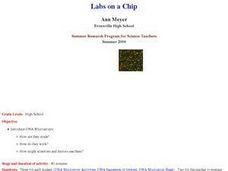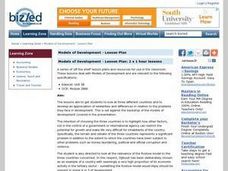Curated OER
???Autumn in the Palace of the Han??? by Ma chih-yuan
Students read and analyze a play that takes place in the late 1200s under the Yuan dynasty of the Mongols. They examine the structure of Yuan plays, participate in performing sections of the play, write a three page essay, and analyze...
Curated OER
Ivanov Goes to Moscow
Students complete a unit on the play, "Ivanov" by Chekhov. They read and analyze the play, write a short story, watch a film of the play, complete a data sheet, and conduct a debate.
Curated OER
Labs on A Chip
Students are introduced to DNA microarrays. They discuss how scientists and doctors use them and how they work. They complete a worksheet and discuss their findings.
Curated OER
Models of Development
Students examine the main characteristics of models of development. They list the limitations of each model. They compare and contrast the models and explain how they would move a business toward further development.
Curated OER
Mapping an Artifact
Students copy a present day artifact onto graph paper. In groups, they decide the scale of the drawing and create the picture using specific graphing points. They are also given photographs in which there are no graphing points and they...
Curated OER
2 x 2
Learners work together to grid a 2 x 2 meter unit using the formula for the Pythagorean Theorem. After creating the grid, they identify the location of artifacts and create a map of their location. They develop a graph and table of their...
Curated OER
Researching Another country's Holiday: Organizing and Recording Information
Prior to this lesson plan, 5th graders will have collected notes from several sources. Students extend their note taking to include at least one example each of summarizing and paraphrasing. They record bibliographic information for each...
Curated OER
Cutting the Wood
Students demonstrate and describe the effect of multiplying or dividing by a fraction less than or greater than one. They create and explain a variety of equivalent ratios that represent a given situation. Students draw a picture of...
Curated OER
Walking Home
Students discover the formulas for calculating distance. In groups, they solve equations determine the distance in a specific amount of time. They record their answers in a chart or graph and compare them with their classmates.
Curated OER
Missed The Boat
Pupils complete time and distance problems. Using appropriate problem solving strategies, students determine when a helicopter will catch a cruise ship. Pupils write a summary of their solution process. They complete a graph to...
Curated OER
Weather Proverbs
Middle schoolers investigate various concepts related to weather. They conduct historical research to see how the study of weather originated and the application of the latest technologies in the field. Students summarize the information...
Curated OER
Time-Lapsed Observations
Learners explore timed observations for science investigations. They record ideas on a chart related to a classroom closed terrarium. They repeat their observations for several days and time observations for changing shadows during the...
Curated OER
Science Reporter for Where in the World is Science? Project
Students take the role of a science reporter and gather data for a newspaper article. Students create a question sheet. Students receive a copy of the Science Reporter's Journal task sheet. They complete the items on the sheet and...
Curated OER
Molar Ratio
Students conduct an experiment in which they react sodium bicarbonate with hydrochloric acid to determine the molar ration between the two reactants. Students must write correct formula and a balanced chemical equation and explain how...
Curated OER
Types of Groups
Middle schoolers are introduced to the various types of groups in a society. In groups, they create a chart showing the similarities and differences between primary, secondary, and reference groups. Using magazines, they cut out...
Curated OER
Luck of the Draw
Students explore the Spanish language. They review their assessment task and rubric and play a card game. They draw cards containing instructions and phrases in Spanish and perform the instructions on the card in Spanish. They continue...
Curated OER
Land Bridge Theory
Fifth graders observe a map that includes where the land bridge was located and that its name was Beringia and look in the Social Studies books to read about the Land Bridge Theory. The class then brainstorms reasons why they think...
Curated OER
Nutrition and the Food Pyramid
First graders examine the food pyramid and how healthy food effects the body. They discuss what they ate for breakfast and identify what makes a food healthy. Students analyze the food pyramid, and cut out magazine pictures of food and...
Curated OER
Germs
First graders discuss as a class how many of them have sneezed today. They then listen as the teacher explains that germs come out of their nose during a sneeze or when they blow their nose. They then discuss other ways that a person...
Curated OER
Mars
First graders listen as the teacher reads a copy of the WEEKLY READER that talks about Mars and ask questions accordingly. They again listen as a section about Earth is read from the magazine. Now, the class orally compare and contrast...
Curated OER
Graphs
Students create "snowballs" from crumbled pieces of white paper. They then glue their snowball to the appropriate side of the graph to indicate who has and who has not thrown a snowball. The teacher and the calss then will count how many...
Curated OER
the Impact of the U.s. Supreme Court on High School Journalism.
Young scholars study of the First Amendment, Tinker, Hazelwood and the Colorado Student Free Expression Law. They discuss the ramifications on the student press and recite their memorized First Amendment rights. They discover what...
Curated OER
From Forest to Farm and Back Again
Young scholars review and discuss a given set of questions regarding ecosystems. They analyze essays, maps and historical documents on timber harvesting and regeneration and then complete worksheets.
Curated OER
Now You See Me, Now You Don't
Second graders develop an awareness of the power of their minds to work with visual images. All the activities in this unit help strengthen visualization that is an important tool or process in Geometry.
Other popular searches
- Drama Stage Directions
- Stage Directions Play
- Theater Stage Directions
- Scenes Acts Stage Directions
- Stage Directions Grade 6
- Lessons on Stage Directions
- Stage Directions Midsummer
- Tempest Stage Directions























